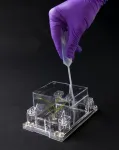(Press-News.org) In a world striving for sustainability, understanding the hidden half of a living plant – the roots – is crucial. Roots are not just an anchor; they are a dynamic interface between the plant and soil, critical for water uptake, nutrient absorption, and, ultimately, the survival of the plant. In an investigation to boost agricultural yields and develop crops resilient to climate change, scientists from Lawrence Berkeley National Laboratory’s (Berkeley Lab’s) Applied Mathematics and Computational Research (AMCR) and Environmental Genomics and Systems Biology (EGSB) Divisions have made a significant leap. Their latest innovation, RhizoNet, harnesses the power of artificial intelligence (AI) to transform how we study plant roots, offering new insights into root behavior under various environmental conditions.
This pioneering tool, detailed in a study published on June 5 in Scientific Reports, revolutionizes root image analysis by automating the process with exceptional accuracy. Traditional methods, which are labor-intensive and prone to errors, fall short when faced with the complex and tangled nature of root systems. RhizoNet steps in with a state-of-the-art deep learning approach, enabling researchers to track root growth and biomass with precision. Using an advanced deep learning-based backbone based on a convolutional neural network, this new computational tool semantically segments plant roots for comprehensive biomass and growth assessment, changing the way laboratories can analyze plant roots and propelling efforts toward self-driving labs.
As Berkeley Lab’s Daniela Ushizima, lead investigator of the AI-driven software, explained, “The capability of RhizoNet to standardize root segmentation and phenotyping represents a substantial advancement in the systematic and accelerated analysis of thousands of images. This innovation is instrumental in our ongoing efforts to enhance the precision in capturing root growth dynamics under diverse plant conditions.”
Getting to the Roots
Root analysis has traditionally relied on flatbed scanners and manual segmentation methods, which are not only time-consuming but also susceptible to errors, particularly in extensive multi-plant studies. Root image segmentation also presents significant challenges due to natural phenomena like bubbles, droplets, reflections, and shadows. The intricate nature of root structures and the presence of noisy backgrounds further complicate the automated analysis process. These complications are particularly acute at smaller spatial scales, where fine structures are sometimes only as wide as a pixel, making manual annotation extremely challenging even for expert human annotators.
EGSB recently introduced the latest version (2.0) of EcoFAB, a novel hydroponic device that facilitates in-situ plant imaging by offering a detailed view of plant root systems. EcoFAB – developed via a collaboration between EGSB, the DOE Joint Genome Institute (JGI), and the Climate & Ecosystem Sciences division at Berkeley Lab – is part of an automated experimental system designed to perform fabricated ecosystem experiments that enhance data reproducibility. RhizoNet, which processes color scans of plants grown in EcoFAB that are subjected to specific nutritional treatments, addresses the scientific challenges of plant root analysis. It employs a sophisticated Residual U-Net architecture (an architecture used in semantic segmentation that improves upon the original U-Net by adding residual connections between input and output blocks within the same level, i.e. resolution, in both the encoder and decoder pathways) to deliver root segmentation specifically adapted for EcoFAB conditions, significantly enhancing prediction accuracy. The system also integrates a convexification procedure that serves to encapsulate identified roots from time series and helps quickly delineate the primary root components from complex backgrounds. This integration is key for accurately monitoring root biomass and growth over time, especially in plants grown under varied nutritional treatments in EcoFABs.
To illustrate this, the new Scientific Reports paper details how the researchers used EcoFAB and RhizoNet to process root scans of Brachypodium distachyon (a small grass species) plants subjected to different nutrient deprivation conditions over approximately five weeks. These images, taken every three to seven days, provide vital data that help scientists understand how roots adapt to varying environments. The high-throughput nature of EcoBOT, the new image acquisition system for EcoFABs, offers research teams the potential for systematic experimental monitoring – as long as data is analyzed promptly.
“We’ve made a lot of progress in reducing the manual work involved in plant cultivation experiments with the EcoBOT, and now RhizoNet is reducing the manual work involved in analyzing the data generated,” noted Peter Andeer, a research scientist in EGSB and a lead developer of EcoBOT, who collaborated with Ushizima on this work. “This increases our throughput and moves us toward the goal of self-driving labs.” Resources at the National Energy Research Scientific Computing Center (NERSC) – a U.S. Department of Energy (DOE) user facility located at Berkeley Lab – were used to train RhizoNet and perform inference, bringing this capability of computer vision to the EcoBOT, Ushizima noted.
“EcoBOT is capable of collecting images automatically, but it was unable to determine if how athe plant responds to different environmental changes alive or not or growing or not,” Ushizima explained. “By measuring the roots with RhizoNet, we capture detailed data on root biomass and growth not solely to determine plant vitality but to provide comprehensive, quantitative insights that are not readily observable through conventional means. After training the model, it can be reused for multiple experiments (unseen plants).”
“In order to analyze the complex plant images from the EcoBOT, we created a new convolutional neural network for semantic segmentation," added Zineb Sordo, a computer systems engineer in AMCR working as a data scientist on the project. "Our goal was to design an optimized pipeline that uses prior information about the time series to improve the model's accuracy beyond manual annotations done on a single frame. RhizoNet handles noisy images, detecting plant roots from images so biomass and growth can be calculated.”
One Patch at a Time
During model tuning, the findings indicated that using smaller image patches significantly enhances the model's performance. In these patches, each neuron in the early layers of the artificial neural network has a smaller receptive field. This allows the model to capture fine details more effectively, enriching the latent space with diverse feature vectors. This approach not only improves the model's ability to generalize to unseen EcoFAB images but also increases its robustness, enabling it to focus on thin objects and capture intricate patterns despite various visual artifacts.
Smaller patches also help prevent class imbalance by excluding sparsely labeled patches – those with less than 20% of annotated pixels, predominantly background. The team’s results show high accuracy, precision, recall, and Intersection over Union (IoU) for smaller patch sizes, demonstrating the model's improved ability to distinguish roots from other objects or artifacts.
To validate the performance of root predictions, the paper compares predicted root biomass to actual measurements. Linear regression analysis revealed a significant correlation, underscoring the precision of automated segmentation over manual annotations, which often struggle to distinguish thin root pixels from similar-looking noise. This comparison highlights the challenge human annotators face and showcases the advanced capabilities of the RhizoNet models, particularly when trained on smaller patch sizes.
This study demonstrates the practical applications of RhizoNet in current research settings, the authors noted, and lays the groundwork for future innovations in sustainable energy solutions as well as carbon-sequestration technology using plants and microbes. The research team is optimistic about the implications of their findings.
“Our next steps involve refining RhizoNet’s capabilities to further improve the detection and branching patterns of plant roots,” said Ushizima. "We also see potential in adapting and applying these deep-learning algorithms for roots in soil as well as new materials science investigations. We're exploring iterative training protocols, hyperparameter optimization, and leveraging multiple GPUs. These computational tools are designed to assist science teams in analyzing diverse experiments captured as images, and have applicability in multiple areas.”
Further research work in plant root growth dynamics is described in a pioneering book on autonomous experimentation edited by Ushizima and Berkeley Lab colleague Marcus Noack that was released in 2023. Other team members from Berkeley Lab include Peter Andeer, Trent Northen, Camille Catoulos, and James Sethian. This multidisciplinary group of scientists is part of Twin Ecosystems, a DOE Office of Science Genomic Science Program project that integrates computer vision software and autonomous experimental design software developed at Berkeley Lab (gpCAM) with an automated experimental system (EcoFAB and EcoBOT) to perform fabricated ecosystem experiments and enhance data reproducibility. The work of analyzing plant roots under different kinds of nutrition and environmental conditions is also part of the DOE’s Carbon Negative Earthshot initiative (see sidebar).
END
Berkeley Lab researchers advance AI-driven plant root analysis
Enhancing biomass assessment and plant root growth monitoring in hydroponic systems
2024-06-21
ELSE PRESS RELEASES FROM THIS DATE:
Cleveland Clinic study shows weight loss surgery cuts risk of heart complications and death in patients with obstructive sleep apnea and obesity
2024-06-21
Press release under embargo:
Cleveland Clinic Study Shows Weight Loss Surgery Cuts Risk of Heart Complications and Death in Patients with Obstructive Sleep Apnea and Obesity
First-of-its-kind MOSAIC study shows weight-loss surgery is associated with a 42% reduction in risk of heart complications and 37% reduction in risk of death in patients with obstructive sleep apnea
Under embargo until Friday, June 21, 2024, 9:00 AM ET, CLEVELAND: A Cleveland Clinic study shows that bariatric surgery performed in patients with obesity and moderate to severe obstructive sleep apnea is associated with a significantly lower risk of ...
SQUID pries open AI black box
2024-06-21
Artificial intelligence continues to squirm its way into many aspects of our lives. But what about biology, the study of life itself? AI can sift through hundreds of thousands of genome data points to identify potential new therapeutic targets. While these genomic insights may appear helpful, scientists aren’t sure how today’s AI models come to their conclusions in the first place. Now, a new system named SQUID arrives on the scene armed to pry open AI’s black box of murky internal logic.
SQUID, ...
Resiliency shaped by activity in the gut microbiome and brain
2024-06-21
A new UCLA Health study has found that resilient people exhibit neural activity in the brain regions associated with improved cognition and regulating of emotions, and were more mindful and better at describing their feelings. The same group also exhibited gut microbiome activity linked to a healthy gut, with reduced inflammation and gut barrier.
For the study, rather than examine microbiome activity and composition linked to disease conditions-- like anxiety and depression -- the researchers wanted to flip the script and study the gut microbiome and brain in healthy, resilient people who effectively cope with different types of stress, including discrimination ...
Inspired by nature: synthetic nightshade molecule effective against leukemia cells
2024-06-21
Nightshade plants produce a diverse array of compounds with therapeutic potential. Researchers at CeMM have now identified an artificial variant inspired by the Withanolides group that acts highly specifically against leukemia cells. Using state-of-the-art chemical and genetic high-throughput analyses, the team led by Georg Winter not only confirmed its effectiveness but also elucidated its mechanism of action: the molecule disrupts the cholesterol metabolism of tumor cells. The study's findings ...
Promise green hydrogen may not always be fulfilled
2024-06-21
Green hydrogen often, but certainly not always, leads to CO2 gains. This claim is based on research published in Nature Energy by Kiane de Kleijne from Radboud University and Eindhoven University of Technology. “If you calculate the entire life cycle of green hydrogen production and transport, CO2 gains may be disappointing. However, if green hydrogen is produced from very clean electricity and locally, it can really help reduce emissions.”
It is thought that green hydrogen can make ...
Unifying behavioral analysis through animal foundation models
2024-06-21
Although there is the saying, “straight from the horse’s mouth”, it's impossible to get a horse to tell you if it's in pain or experiencing joy. Yet, its body will express the answer in its movements. To a trained eye, pain will manifest as a change in gait, or in the case of joy, the facial expressions of the animal could change. But what if we can automate this with AI? And what about AI models for cows, dogs, cats, or even mice? Automating animal behavior not only removes observer bias, but it helps humans more efficiently get to the right answer.
Today ...
Up to 30 percent more time: Climate change makes it harder for women to collect water
2024-06-21
Climate change could increase the amount of time women spend collecting water by up to 30 percent globally by 2050, according to a new study published in Nature Climate Change. In regions of South America and Southeast Asia, the time spent collecting water could double due to higher temperatures and less rainfall. A team of scientists from the Potsdam Institute for Climate Impact Research (PIK) estimates the large welfare losses that could result from climate impacts and highlights how women are particularly vulnerable to changing future climate conditions. Worldwide, two billion people currently lack access to safe drinking water. The ...
Heart failure in space: scientists calculate potential health threats facing future space tourists in microgravity
2024-06-21
[The following is a guest editorial written by Dr Lex van Loon, an assistant professor at the Australian National University and the University of Twente in the Netherlands. He is co-author of a new Frontiers in Physiology article.]
Space exploration has always captivated our imagination, offering the promise of discovering new worlds and pushing the boundaries of human capability. As commercial space travel becomes more accessible, individuals with various underlying health conditions—including heart failure—may soon be among those venturing beyond Earth’s atmosphere. This raises critical questions about the impact of space travel ...
Experts offer guidance on talking with children about racism at pediatrician's office
2024-06-21
Extensive research shows the link between exposure to racism during childhood and adolescence and increased risks of depression and metabolic health issues, such as obesity, diabetes and heart disease. Conversely, racial socialization, described as behaviors and practices that teach children about race and ethnic identity, has shown potential in mitigating these negative effects, and discussions like these could be effective in pediatric clinics, according to the first expert consensus guidance on this topic published in Pediatrics.
“Over the years, numerous calls to action have been made to address racism in medicine. ...
Drugs for HIV and AIDS trialed as brain tumor treatment for first time
2024-06-21
Drugs developed to combat HIV and AIDS are being trialled for the first time in patients with multiple brain tumours.
Scientists at the Brain Tumour Research Centre of Excellence at the University of Plymouth are conducting a clinical trial to see whether using anti-retroviral medications, Ritonavir and Lopinavir, could help people with Neurofibromatosis 2 (NF2).
The rare inherited genetic condition causes tumours such as schwannoma (which include acoustic neuroma), ependymoma and meningioma which develop ...
LAST 30 PRESS RELEASES:
Numbers in our sights affect how we perceive space
SIMJ announces global collaborative book project in commemoration of its 75th anniversary
Air pollution exposure and birth weight
Obstructive sleep apnea risk and mental health conditions among older adults
How talking slows eye movements behind the wheel
The Ceramic Society of Japan’s Oxoate Ceramics Research Association launches new international book project
Heart-brain connection: international study reveals the role of the vagus nerve in keeping the heart young
Researchers identify Rb1 as a predictive biomarker for a new therapeutic strategy in some breast cancers
Survey reveals ethical gaps slowing AI adoption in pediatric surgery
Stimulant ADHD medications work differently than thought
AI overestimates how smart people are, according to HSE economists
HSE researchers create genome-wide map of quadruplexes
Scientists boost cell "powerhouses" to burn more calories
Automatic label checking: The missing step in making reliable medical AI
Low daily alcohol intake linked to 50% heightened mouth cancer risk in India
American Meteorological Society announces Rick Spinrad as 2026 President-Elect
Biomass-based carbon capture spotlighted in newly released global climate webinar recording
Illuminating invisible nano pollutants: advanced bioimaging tracks the full journey of emerging nanoscale contaminants in living systems
How does age affect recovery from spinal cord injury?
Novel AI tool offers prognosis for patients with head and neck cancer
Fathers’ microplastic exposure tied to their children’s metabolic problems
Research validates laboratory model for studying high-grade serous ovarian cancer
SIR 2026 delivers transformative breakthroughs in minimally invasive medicine to improve patient care
Stem Cell Reports most downloaded papers of 2025 highlight the breadth and impact of stem cell research
Oxford-led study estimates NHS spends around 3% of its primary and secondary care budget on the health impacts of heat and cold in England
A researcher’s long quest leads to a smart composite breakthrough
Urban wild bees act as “microbial sensors” of city health.
New study finds where you live affects recovery after a hip fracture
Forecasting the impact of fully automated vehicle adoption on US road traffic injuries
Alcohol-related hospitalizations from 2016 to 2022
[Press-News.org] Berkeley Lab researchers advance AI-driven plant root analysisEnhancing biomass assessment and plant root growth monitoring in hydroponic systems





